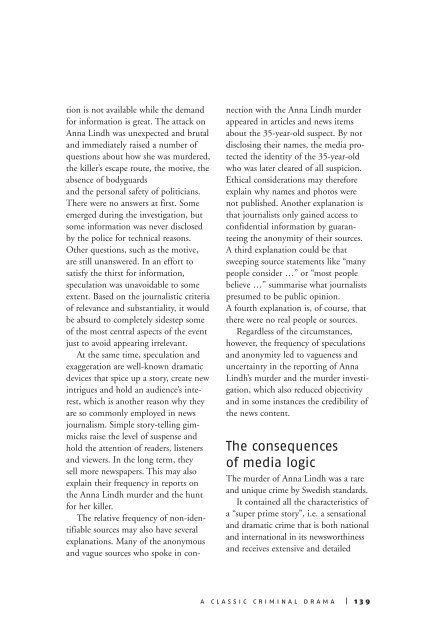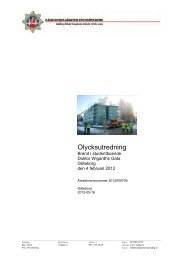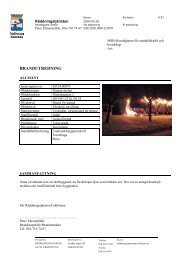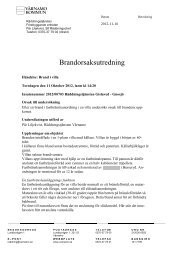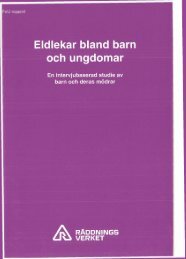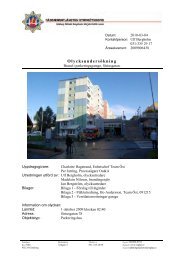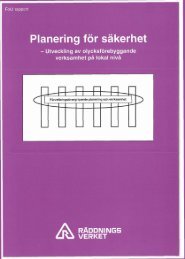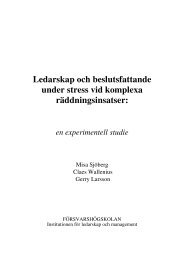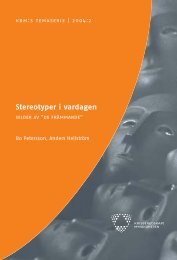Create successful ePaper yourself
Turn your PDF publications into a flip-book with our unique Google optimized e-Paper software.
tion is not available while the demand<br />
for information is great. The attack on<br />
Anna Lindh was unexpected and brutal<br />
and immediately raised a number of<br />
questions about how she was murdered,<br />
the killer’s escape route, the motive, the<br />
absence of bodyguards<br />
and the personal safety of politicians.<br />
There were no answers at first. Some<br />
emerged during the investigation, but<br />
some information was never disclosed<br />
by the police for technical reasons.<br />
Other questions, such as the motive,<br />
are still unanswered. In an effort to<br />
satisfy the thirst for information,<br />
speculation was unavoidable to some<br />
extent. Based on the journalistic criteria<br />
of relevance and substantiality, it would<br />
be absurd to completely sidestep some<br />
of the most central aspects of the event<br />
just to avoid appearing irrelevant.<br />
At the same time, speculation and<br />
exaggeration are well-known dramatic<br />
devices that spice up a story, create new<br />
intrigues and hold an audience’s interest,<br />
which is another reason why they<br />
are so commonly employed in news<br />
journalism. Simple story-telling gimmicks<br />
raise the level of suspense and<br />
hold the attention of readers, listeners<br />
and viewers. In the long term, they<br />
sell more newspapers. This may also<br />
explain their frequency in reports on<br />
the Anna Lindh murder and the hunt<br />
for her killer.<br />
The relative frequency of non-identifiable<br />
sources may also have several<br />
explanations. Many of the anonymous<br />
and vague sources who spoke in connection<br />
with the Anna Lindh murder<br />
appeared in articles and news items<br />
about the 35-year-old suspect. By not<br />
disclosing their names, the media protected<br />
the identity of the 35-year-old<br />
who was later cleared of all suspicion.<br />
Ethical considerations may therefore<br />
explain why names and photos were<br />
not published. Another explanation is<br />
that journalists only gained access to<br />
confidential information by guaranteeing<br />
the anonymity of their sources.<br />
A third explanation could be that<br />
sweeping source statements like “many<br />
people consider …” or “most people<br />
believe …” summarise what journalists<br />
presumed to be public opinion.<br />
A fourth explanation is, of course, that<br />
there were no real people or sources.<br />
Regardless of the circumstances,<br />
however, the frequency of speculations<br />
and anonymity led to vagueness and<br />
uncertainty in the reporting of Anna<br />
Lindh’s murder and the murder investigation,<br />
which also reduced objectivity<br />
and in some instances the credibility of<br />
the news content.<br />
The consequences<br />
of media logic<br />
The murder of Anna Lindh was a rare<br />
and unique crime by Swedish standards.<br />
It contained all the characteristics of<br />
a “super prime story”, i.e. a sensational<br />
and dramatic crime that is both national<br />
and international in its newsworthiness<br />
and receives extensive and detailed<br />
a classic criminal drama | 139


